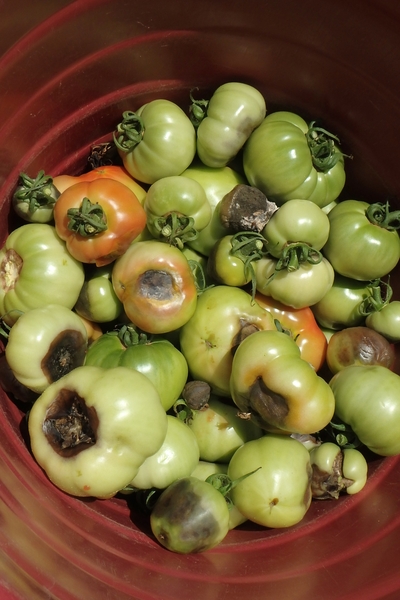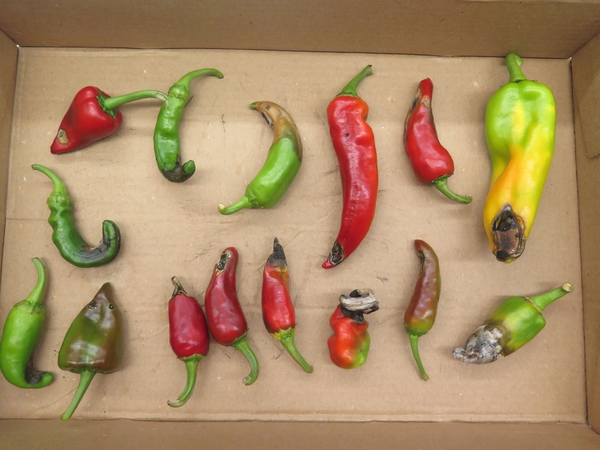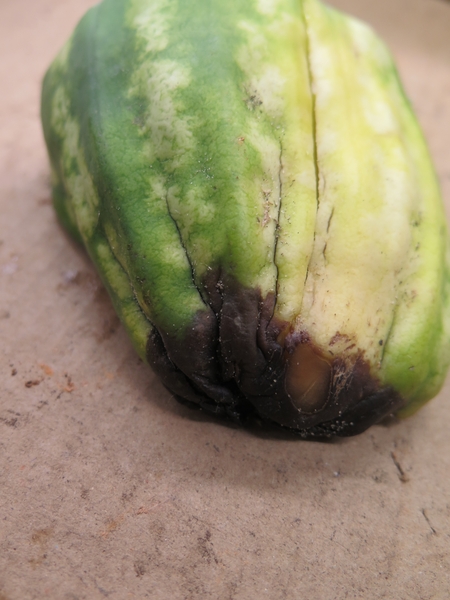General Information
Blossom-end rot is an abiotic (caused by a non-living factor) disease of tomato, pepper and watermelon. Yield losses can vary from a trace to more than 50 percent with no control measures.
Symptoms
Symptoms of blossom end rot only appear on fruit, however, a calicum defiiciency can be detected before plants set fruit in the form of stunting and necrosis of new leaves. The first symptoms on fruit are a slight water-soaked area on or near the blossom end of the fruit, although lesions can form on the sides of fruit. The affected area soon darkens and enlargens in a constantly widening circle as the fruit ripens. The affected tissue becomes dark, shrunken, and has a dry, leathery appearance. Half or more of the fruit may be affected, and secondary organisms may colonize the tissue, giving it a black color (Figures 1, 2, and 3).
Lookalike conditions. With pepper, blossom end rot is tan in color and can be confused with sunscald, which initially appears white but turns tan. Blossom end rot will most often appear on the blossom-end of the fruit whereas sunscald will affect parts of the fruit exposed to the sun.
Cause
Blossom end rot is caused by a lack of calcium in the developing fruit. This may be due to a lack of calcium uptake from the soil or to extreme fluctuations in water supply. Calcium is a mobile nutrient and must move to developing fruit via transportation of water. Incidence of blossom-end rot is also increased where there is a low ratio of calcium to certain other nutrients, such as nitrogen and magnesium, or excessively saline soil.
Control
Although the most desirable calcium levels for preventing blossom-end rot have not been determined, the application of lime to fields known to be low in calcium has helped to prevent the disease. Soil should be limed according to recommendations of soil analysis report, usually to pH 6.5-6.8. The use of gypsum (land plaster), at rates of 500 to 1000 pounds per acre (1 to 2 pounds per 100 square feet) as a supplement to liming on calcium deficient soils has proven beneficial. Lime and/or gypsum should be applied several months in advance of planting.
After tomatoes are planted, good results have been obtained by spraying foliage and stems with anhydrous calcium chloride (4 pounds per 100 gallons of water per acre) four times on a weekly schedule beginning when the second forms, or when symptoms first appear. Calcium chloride solutions are also available under several trade names for small scale garden use. Application in the same tank with fungicides and/or insecticides is suggested. This helps to rapidly place calcium directly where it is needed in the fruits. Do not exceed the recommended rate. Calcium chloride is suggested only for tomatoes. Application should be done while temperatures are cool in the morning
Since blossom-end rot is so closely related to extremes in the water supply, an important aid in control is to regulate moisture supply in the soil. Cultivation and hoeing can be avoided if proper weed-control chemicals are used. If cultivation is necessary, it should be shallow to avoid root pruning. Mulching, which serves to maintain an even supply of soil moisture, should be practiced where feasible and irrigation supplied via a drip system so that applications can be made during hot and dry weather. To reemphasize, either an inadequate or excess moisture stress favors blossom-end rot development. In general, plants need at least one inch of water per week in the form of rain or supplemental irrigation.
Young plants should not be grown too quickly nor should the plants be subjected to severe "hardening-off" before transplanting. A steady growth rate as a seedling and in the field will discourage this trouble. Removing affected fruits when symptoms are first observed may be worthwhile for subsequent development of other fruit on the plant. This is particularly recommended for tomatoes.
Other Links
- The NC State Plant Disease and Insect Clinic provides diagnostics and control recommendations
- The NC State Extension Plant Pathology Portal provides information on crop disease management
- The Southeastern US Vegetable Crop Handbook provides information on vegetable disease management
For assistance with a specific problem, contact your local N.C. Cooperative Extension center.
Note on Recommendations
Recommendations of specific chemicals are based upon information on the manufacturer's label and performance in a limited number of trials. Because environmental conditions and methods of application by growers may vary widely, performance of the chemical will not always conform to the safety and pest control standards indicated by experimental data. All recommendations for pesticide use were legal at the time of publication, but the status of registration and use patterns are subject to change by actions of state and federal regulatory agencies.
References
Compendium of Tomato Diseases and Pests, Second Edition. 2014. The American Phytopathological Society.
Compendium of Pepper Diseases. 2003. The American Phytopathological Society.
Publication date: Dec. 16, 2013
N.C. Cooperative Extension prohibits discrimination and harassment regardless of age, color, disability, family and marital status, gender identity, national origin, political beliefs, race, religion, sex (including pregnancy), sexual orientation and veteran status.



